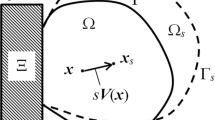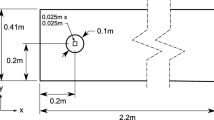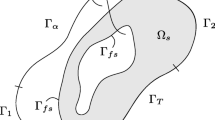Abstract
A method for shape design sensitivity analysis of two-dimensional thermal conducting solid is presented using the material derivative concept and the adjoint variable method. A general thermal boundary condition with heat convection is considered in addition to prescribed temperature and heat flux. The method for deriving the sensitivity formula is based on standard direct boundary integral equation formulation. The sensitivity of a general functional depending on temperature and heat flux is considered. The method is then applied to obtain the sensitivity analysis is demonstrated by a hollow cylinder problem with exact solution. A weight minimization problem of a thermal diffuser is considered as a practical application. The sensitivity by the presented method is compared with that by finite differences and an optimal shape is found by use of an optimization routine.
Similar content being viewed by others
References
Arora, J.S., 1984, “An Algorithm for Optimum Structural Design without Line Search,” in E. Atrek (ed.), New Directions in Optimum Structural Design, Wiley, New York, pp. 429–441.
Banerjee, P.K. and Butterfield, R., 1981, “Boundary Element Methods in Engineering Science,” McGraw-Hill, New York.
Barone, M.R. and Yang R.J., 1988, “Boundary Integral Equations for Recovery of Design Sensitivities in Shape Optimization,” AIAA J., Vol. 26, pp. 589–594.
Barone, M.R. and Yang, R.J., 1989, “A Boundary Element Approach for Recovery of Shape Sensitivities in Three-dimensional Elastic Solids,” Comp. Meth. Appl. Mech. Eng., Vol. 74, pp. 69–82.
Brebbia, C.A., Telles, J.C.F. and Wrobel, L.C., 1984, “Boundary Element Techniques,” Springer-Verlag, Berlin and New York.
Carslaw, H.S. and Jaeger, J.C., 1959, “Conduction of Heat in Solids,” Oxford University Press, London, pp. 188–189.
Choi, J.H. and Choi, K.K., 1990, “Direct Differentiation Method for Shape Design Sensitivity Analysis Using Boundary Integral Formulation,” Comp. Struct., Vol. 34, pp. 499–508.
Choi, J.H. and Kwak, B.M., 1988a, “Shape Design Sensitivity Analysis of Elliptic Problems in Boundary Integral Equation Formulation,” Mech. Struct. Machines, Vol. 16, pp. 147–165.
Choi, J.H. and Kwak, B.M., 1988b, “Boundary Integral Equation Method for Shape Optimization of Elastic Structures,” Int. J. Num. Meth. Eng., Vol. 26, pp. 1579–1595.
Choi, J.H. and Kwak, B.M., 1990, “A Unified Approach for Adjoint and Direct Method in Shape Design Sensitivity Analysis Using Boundary Integral Formulation,” Engineering Analysis with Boundary Elements, Vol. 7, pp. 39–45.
Delfour, M., Payre, G. and Zolesio, J.P., 1983, “Optimal Design of a Minimum Weight Thermal Diffuser with Constraint on the Output Thermal Power Flux,” Appl. Math. Optim., Vol. 9 pp. 225–262.
Dems, K., 1987, “Sensitivity Analysis in Thermal Problems-II: Structural Shape Variation,” J. Therm. Stresses, Vol. 10, pp. 1–16.
Haug, E.J., Choi, K.K. and Komkov, V., 1986, “Design Sensitivity Analysis of Structural Systems,” Academic Press, New York.
Kane, J.H., Kumar, B.L.K. and Stabinsky, M., 1991, “Transient Thermoelasticity and Other Body Force Effects in Boundary Element Shape Sensitivity Analysis,” Int. J. Num. Meth. Eng., Vol. 31, pp. 1203–1230.
Kane, J.H. and Saigal, S., 1988, “Design Sensitivity Analysis of Solids Using BEM,” J. Engng. Mech., Vol. 114, pp. 1703–1722.
Kwak, B.M. and Choi, J.H., 1987, “Shape Design Sensitivity Analysis Using Boundary Integral Equation for Potential Problem,” in C.A. Mota Soares (ed.), Computer Aided Optimal Design: Structural and Mechanical Systems, Springer-Verlag, Berlin Heidelberg, pp. 633–642.
Kwak, B.M. and Lee, B.Y., 1990, “Shape Design Sensitivity Analysis of Thermoelasticity Problem Using Boundary Integral Equation Formulation,” in M. Tanaka et al. (eds.), BEM XII Vol. 2: Applications in Fluid Mechanics and Field Problems, Springer-Verlag, Berlin Heidelberg, pp. 215–224.
Lee, B.Y. and Kwak, B.M., 1991, “Shape Optimization of Two-dimensional Thermoelastic Structures Using Boundary Integral Equation Formulation,” Comp. Struct., Vol. 41, pp. 709–722.
Lee, B.Y. and Kwak, B.M., 1992, “Axisymmetric Thermoelastic Shape Sensitivity Analysis and Its Application to Turbine Disc Design,” Int J. Num. Meth. Eng., Vol. 33, pp. 2073–2089.
Meric, R.A., 1988, “Shape Design Sensitivity Analysis for Nonlinear Anisotropic Heat Conducting Solids and Shape Optimization by the BEM,” Int. J. Num. Meth. Eng., Vol. 26, pp. 109–120.
Mota Soares, C.A., Leal, R.P. and Choi, K.K., 1987, “Boundary Elements in Shape Optimal Design of Structural Components,” in C.A. Mota Soares (ed.), Computer Aided Optimal Design: Structural and Mechanical Systems, Springer-Verlag, Berlin Heidelberg, pp. 605–631.
Park, C.W. and Yoo, Y.M., 1988, “Shape Design Sensitivity Analysis of a Two-dimensional Heat Transfer System Using the Boundary Element Method,” Comp. Struct., Vol. 28, pp. 543–550.
Rice, J.S. and Mukherjee, S., 1990, “Design Sensitivity Coefficients for Axisymmetric Elasticity Problems by Boundary Element Methods,” Engineering Analysis with Boundary Elements, Vol. 7, pp. 13–20.
Saigal, S., Borggaard, J.T. and Kane, J.H., 1989, “Boundary Element Implicit Differentiation Equations for Design Sensitivities of Axisymmetric Structures,” Int. J. Solids Struct., Vol. 25, pp. 527–538.
Tortorelli, D.A., Haber, R.B. and Lu, S.C.Y., 1989, “Design Sensitivity Analysis for Nonlinear Thermal Systems,” Comp. Meth. Appl. Mech. Eng., Vol. 77, pp. 61–77.
Author information
Authors and Affiliations
Rights and permissions
About this article
Cite this article
Lee, B.Y., Choi, J.H. & Kwak, B.M. Shape optimization of two-dimensional thermal conducting solid using boundary integral equation formulation. KSME Journal 6, 114–121 (1992). https://doi.org/10.1007/BF02953079
Received:
Issue Date:
DOI: https://doi.org/10.1007/BF02953079




